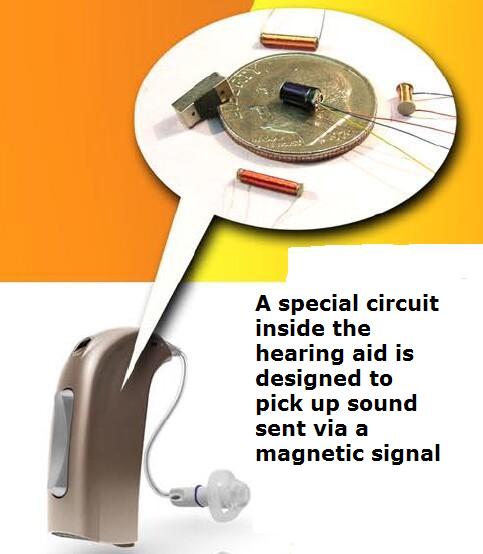What is a Telecoil?
What is a telecoil?
A telecoil is also known as a t-coil.
“Ah-Ha” Moment: Evelyn Discovers Telecoil”
A telecoil is a small copper coil that is an option on most hearing aids and is built into cochlear implant processors. They are also known as t-coils and were originally used to boost the magnetic signals from the telephone handset. The telecoil is activated by a t-switch on the hearing aid or cochlear implant. All landlines and some cell phones are designed by law to be used with a telecoil.


The telecoil can make a noticeable difference in your life when you combine it with hearing assistive technology. This pairing of technology bridges the physical space between you and the sound source. Hearing assistive technology connects the listener directly to the sound source while most background noise is eliminated.
Which Hearing Aids Will Work with a Hearing Loop?
Most hearing aids are currently supplied with a telecoil as standard but are not always set up to work with a hearing loop. Once the hearing aid has been programmed by an audiologist or hearing aid dispenser to include a telecoil mode or T program, it is usually a simple matter of pressing a button to switch between the hearing aid’s built-in microphone (M) and the telecoil (T). Some hearing aids also offer a combination MT mode to enable the user to hear signals from the telecoil and microphone simultaneously.
If you have hearing aids but don’t know if you have telecoils, ask your audiologist or hearing aid dispenser. Download this form and take it to your dispenser. Taketoaudiologist_Card
When would you use a telecoil?
Increasing the volume of your hearing aid or cochlear implant won’t necessarily increase the clarity of what you hear. Hearing assistive technology combined with a telecoil can improve your understanding of dialogue at work, in a meeting, in the classroom, theaters, places of worship, tour buses, and other places. Some people use telecoils at home with the TV while keeping the TV volume low for the comfort of others.
Many public places are equipped with hearing assistive technology. With the implementation of the Americans with Disabilities Act of 1990, hearing assistive technology is increasingly available in public places.
What is Hearing Assistive Technology? (HAT)
There are three types of wireless hearing assistive technology discussed here: The hearing loop is a wire that circles a room and is connected to the sound system. The loop transmits the sound electromagnetically. The electromagnetic signal is then picked up by the telecoil in the hearing aid or cochlear implant. To use a hearing loop, one easily flips the t-switch on the hearing aid or cochlear implant. No additional receiver or equipment is needed. Using a telecoil and hearing loop together is seamless, cost-effective, unobtrusive, and you don’t have to seek out and obtain special equipment. An infrared system uses invisible light beams to carry sound from the source to a personal receiver. (The sound source must be in the line of sight.) Different types of attachments may be connected to the personal receiver such as a neckloop or a behind-the-ear silhouette inductor. The telecoil then picks up sound from the receiver via the attachment. An FM system works similarly, but the sound is conveyed through radio waves to a personal receiver.
What other uses are there for telecoils?
Telecoils can improve hearing on hearing-aid-compatible phones and can be used with neck loops to replace headphones. A neckloop is similar to a hearing loop, except that it is worn around the neck and can be plugged into other audio devices (such as an MP3 player, computer, or FM or infrared receivers) to transmit the audio signal directly to the hearing aid telecoil, bypassing the need for headphones.
How do you get a telecoil? Are they expensive?
Ask for a telecoil when you buy your hearing aids. A telecoil may add a small amount to the cost of your hearing aid but the benefits far outweigh the cost. Ask your audiologist or hearing instrument specialist to include a telecoil in your hearing aid and ask for advice on how to use it. Many models and styles of hearing aids and all cochlear implants can be fitted with telecoils. Telecoils can sometimes be added to your current hearing aid but it will cost less if you include it in your original purchase.
Purchasing a Hearing Aid
Don’t assume that your hearing aid will automatically come with a telecoil or that it will be recommended. Or, if a telecoil is present, don’t assume it has been programmed to suit your individual needs. Today, approximately 80 percent of all hearing aids dispensed in the United States have telecoils. Yet, few consumers are told about them and know how to use them. Use the Consumer Checklist published by the Hearing Loss Association of America when purchasing a hearing aid (available on www.hearingloss.org or in hard copy). This checklist includes asking about telecoils. Some states have laws that require audiologists and hearing instrument specialists to tell consumers about telecoils when purchasing hearing aids. The states with telecoil education laws are Arizona, Florida, New York, Rhode Island, and Utah.
Note: Automatic telecoils are available but work only with telephones, not hearing loops, so ask your audiologist or hearing instrument specialist to include a manually-operated telecoil in your hearing aid and ask for advice on how to use it.
Resource: Content is produced as part of “Get in the Hearing Loop,” a national educational campaign to increase awareness about assistive listening technologies, especially hearing loops and telecoils, that are available to people with hearing loss. The project is a collaborative public awareness campaign developed by the Hearing Loss Association of America (HLAA) and the American Academy of Audiology
Get instructions here for your hearing healthcare provider on how to set up your hearing aid(s) or cochlear implant for use with a hearing loop. Ask your audiologist/hearing aid dispenser if your hearing aid(s) are equipped with a telecoil.
Additional videos on Telecoils
Watch Ann Mundell-Noel’s video on T-coils
Hearing Loop Demonstration: What is a Telecoil and How to Activate the Telecoil on your Hearing Aid
Loop Systems and Telecoils for Hearing Aids – Timothy C. Hain, MD Article.
